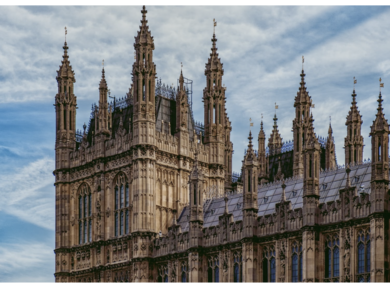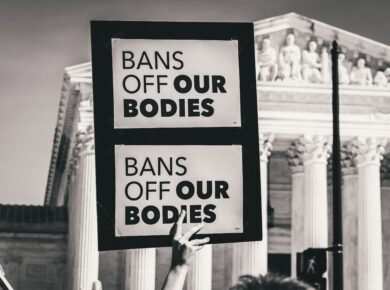Disclaimer: This blog post solely reflects the opinion of the authors and should not be taken to represent the general views of IPPR’s management/ editorial team or those of fellow authors.
What is carbon offsetting?
More than a quarter-million people may die each year due to climate change in the coming decades (Ruiz-Grossman and O’Connor, 2019). This urgent problem calls for solutions and this is what firms seek to propose through carbon offsetting. Presented as a way of compensating for carbon emissions, it is an increasingly popular practice and it has been adopted by big tech companies like Microsoft (Watson, 2021) as well as air travel firms including British Airlines (Abelvik-Lawson and Wockner, 2021).
Carbon offsetting stems from the idea that carbon emissions can be neutralised by investment in schemes which remove carbon from the atmosphere. It is achieved through calculating the cost of carbon emissions (Childs, 2020); which is the quantity emitted multiplied by the carbon credit (amount needed to offset one tonne of CO2) (Chan, 2019), and then investing the equivalent amount in one of the many carbon offsetting schemes available.
Different types of projects are used for carbon offsetting purposes. The most well-known are nature-based programmes, which recreate or restore natural habitats that typically capture CO2 such as forests, wetlands, and marine ecosystems (McCarthy, 2020).
Agricultural solutions exist as well, with a focus on either reducing livestock emissions thanks to the incorporation of small quantities of seaweed in cows’ food (Bryce, 2019), or on improving the capacity of the soil to store carbon (McCarthy, 2020).
Other more technology-intensive techniques exist. Direct air capture, for instance, aims to remove carbon from what factories release in the air thanks to filtration devices. Directly removing carbon from the air is another option. It captures air, eliminates CO2 from it and buries it in the ground, and eventually releases the filtered air (McCarthy, 2020).
Energy-based carbon offsetting techniques are also employed. They consist of either investing in projects that reduce energy consumption through energy-efficient appliances like low consumption light bulbs, or in funding renewable energies, thereby reducing energy-related carbon emissions (Clark, 2011).
Carbon offsetting can also be carried out through landfill management. Indeed, disposal areas release methane that can be captured directly through advanced technological processes (Clark, 2011). This methane can then be destroyed to produce electricity, making this process beneficial in two main ways: it reduces carbon gas emissions and generates energy without further emissions (US EPA, n.d.).
Is carbon offsetting effective?
Carbon offsetting faces many challenges.
Firstly, investments need to fund something that wouldn’t occur naturally, otherwise they are not actually reducing emissions. It requires companies to design or invest in initiatives which go above and beyond the bare minimum of business as usual strategies (McCarthy, 2020). However, this is both hard to ensure and identify as it is difficult to say for certain what would occur without the offsetting investments. For example, a study by the European Commission concluded that most energy related projects are likely to have occurred anyway as a result of strong demand for energy. Furthermore, many governments have pledged to reduce emissions as per the Paris Climate Change Agreement, hence governments will need to invest in the more typical projects (Childs, 2020) such as forest conservation, filtration tanks in factories and others. As a result, many offsetting schemes may not be in addition to what would occur naturally (through government investment) and so are not effective in reducing emissions.
Secondly, even if an offsetting scheme is in fact additional to what would occur otherwise, it also needs to have a permanent impact to be effective. It is easier to ensure the effectiveness of some schemes, especially those which require one-time action; such as carbon capture from power plants, versus other solutions such as those that are nature-based (McCarthy, 2020). For example, if an offsetting initiative plants trees in order to remove CO2 from the atmosphere and then the trees are cut down a couple of decades later, the offset is destroyed and so is ineffective. In addition, the effectiveness of nature-based solutions may be compromised by the election of a new government that is lax in terms of environmental conservation and protection.
Next, ‘leakage’ is yet another challenge facing the effectiveness of carbon offsetting. Leakage is the term used when an offset scheme results in a carbon-producing activity to simply shift to another area (McCarthy, 2020). This can occur when policy or the actions of a company do not consider the external effects of their decisions. For example, policy to conserve one forest in a country may simply lead to loggers moving to an unprotected forest. In the case of individual companies, one company deciding to fuel a power plant by renewable energy does not mean the fossil fuels it previously used are no longer used, instead they may go to a different power plant.
An additional challenge to the effectiveness of carbon offsetting is ‘greenwashing’; the use of an environmentally beneficial activity to hide an environmentally damaging activity or to delay meaningful action (McCarthy, 2020). Many companies, especially fashion brands, are accused of portraying themselves as sustainable when in fact they fail to tackle their environmental impacts (McCarthy, 2020). A potential way in which companies can avoid being accused of greenwashing is by actively pursuing sustainability efforts through using recycled materials which reduces the amount of carbon used in the production process among other things.
Lastly, offsetting schemes cannot be effective when they hurt the local communities they claim to help. There have unfortunately been many instances in which this occurs. One such example is in Uganda, where a private company blocked the local community’s access to vital land for their livelihood in order to plant trees. Another example of this is in Chile and Guatemala, where hydroelectricity projects worsened existing land right conflicts which destroyed social cohesion and damaged the ecosystem (Carbon Market Watch, 2018).
Overall, carbon offsetting may not be an effective answer to solving the climate crisis as it acts as a ‘get out of jail free card’ (Abelvik-Lawson and Wockner, 2021), allowing companies to pay for schemes which effectively make carbon emissions someone else’s problem. In addition, it can become the justification for some companies to increase their emissions rather than work towards decreasing them. As a result, most offsetting schemes are unable to deliver what is necessary- the overall reduction in carbon emissions. Instead, the biggest sources of carbon emissions should be addressed in order to effectively confront the climate crisis. It is crucial that oil and gas companies transition to renewable energy, air travel is reduced or creates less pollution, and nature is protected because it’s valuable (Abelvik-Lawson and Wockner, 2021), not because it allows companies to call their products carbon neutral. For many of these things to occur, policy which incentivises these changes is necessary. For example, those who travel often could be taxed more and the money could be used to conserve forests.
Tackling climate change in an effective way requires the currently available offsetting schemes to be funded by governments across the globe. Meanwhile, the focus of private companies and individuals should be on reducing their emissions, whether that would be in the supply chain, consumption or any other way.
What should the focus be instead?
The greatest weakness of carbon offsetting is the way in which it legitimizes production and consumption practices that emit a lot of carbon and therefore contribute to climate change. Instead of encouraging reflection around how to better respect the environment and adopt sustainable behaviours, it comforts us to continue ‘business as usual’. This willingness to carry on in the same system is particularly linked to consumerism (Watt, 2021: 15).
However, alternatives to carbon offsetting exist, their aim being to reduce carbon emissions in the first place rather than trying to compensate for them.
First, technological change can drastically reduce global carbon emissions. According to the World Economic Forum, digital technologies alone could help reduce global carbon emissions by up to 15% (Ekholm and Rockström, 2019) through innovations in sectors as diverse as energy, agriculture and traffic management. Exponential technologies, namely technologies that have an exponentially increasing output per dollar or per size, have a special role to play in this context. The more time passes, the lower their price and the higher their energetical efficiency, making them a great opportunity to reduce emissions. The next exponential technology in line is 5G as it is more reliable, more secure and consumes less energy than previous connection technologies, which results in less carbon emissions (Ekholm and Rockström, 2019). It is also an example of general-purpose technology, namely a technology that can be applied to several sectors and therefore encourages new innovations (CORE). In fact, the spread of 5G is essential for the development of electric and driverless cars and trucks, which reduce emissions. Such a technology can indeed ensure the reliability, safety and efficiency of driverless vehicles (Ekholm and Rockström, 2019).
Secondly, changing consumer behaviour is crucial to reduce global carbon emissions. It is true that one hundred companies account for 70% of the world’s emissions, hence leading people to think consumer acts are of no use in combating climate change (Del Valle, 2018). However, these companies produce because there is demand for their goods and services. Therefore, consumers can pressure companies by boycotting products that have a high carbon footprint, like cruises or fast fashion. Such behavioural changes can be triggered by several mechanisms, such as making the low carbon option the least costly or the easiest to access, change the presentation of the options to encourage sustainable choices, and ban unsustainable goods and services, among others (UNEP, 2019).
Communication can also play an important role in this field. It is most efficient when it is tailored towards a segment of the population and delivers positive messages. Guilt and fear, that are sometimes spread through environmental communication campaigns, have indeed proven counter-productive because they paralyse people. Moreover, people trust their peers more than the government, meaning that communication channels such as the media, communities or trusted brands must be favoured over direct state communication. Last but not least, non-environmental messages are also preferable because they point at the personal and concrete advantages of having eco-friendly attitudes (Parliament Office of Science and Technology, 2010).
Conclusion
Carbon offsetting is a growing practice that aims at carbon neutrality and allows companies to propose their clients’ ‘sustainable’ purchases. Nonetheless, these carbon offsetting practices are often ‘greenwashing’ campaigns, especially due to the lack of standards and checks in this domain. Instead of trying to offset the carbon emissions of economic activities, more durable solutions to reduce humanity’s carbon footprint could involve not only innovations aiming at more energy-efficient production processes but also policies encouraging behavioural change on the consumer side.
Sources
(n.d.). “Benefits of Landfill Gas Energy Projects”. United States Environmental Protection Agency [online] Available at:







